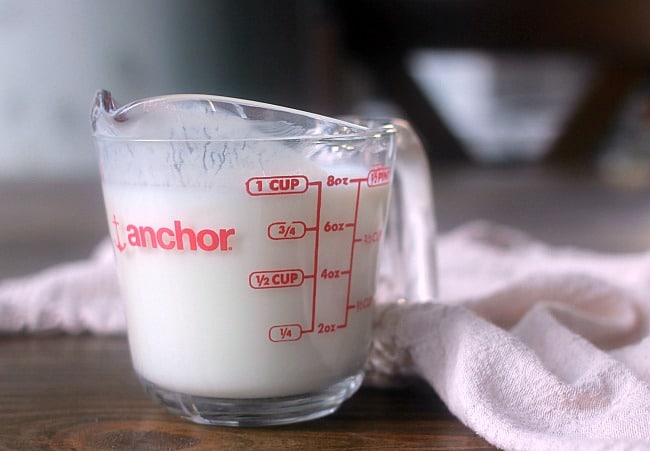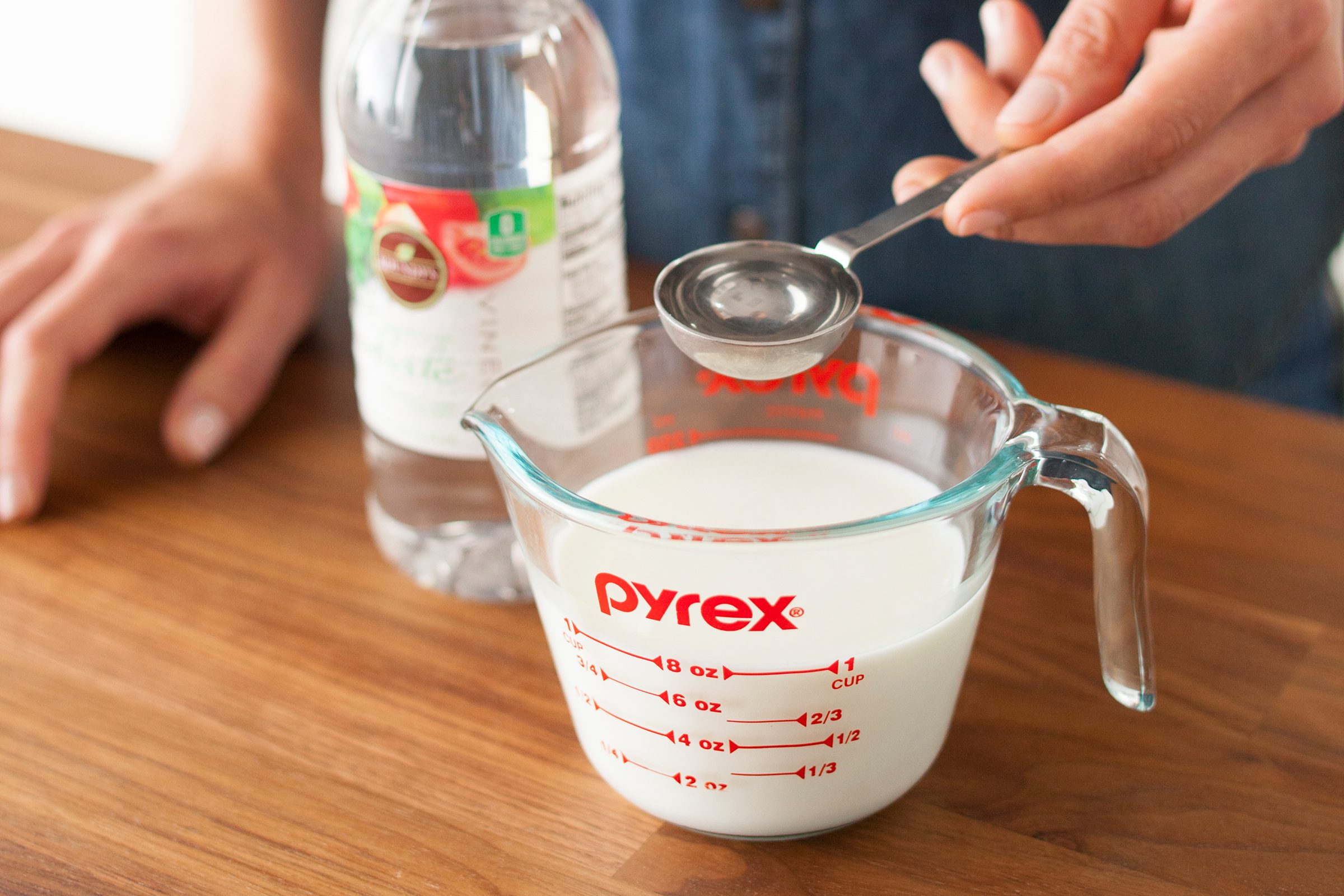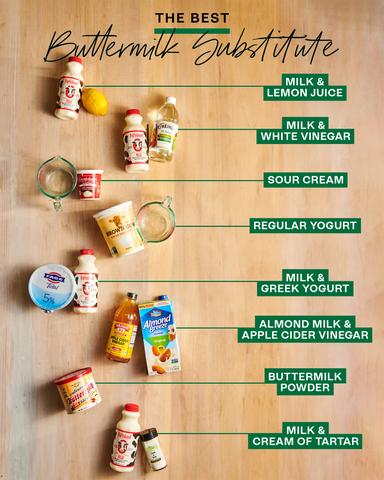
“Discover the Delicious Twist: Buttermilk as a Perfect Substitute for Milk! Unleash the creamy and tangy goodness of buttermilk in your favorite recipes. From fluffy pancakes to creamy dressings, explore the versatility and unique flavor profile that buttermilk brings to your culinary adventures. Upgrade your dishes with this wholesome and slightly acidic alternative, elevating both taste and texture. Let buttermilk add a delightful twist to your kitchen creations!”
Can I Use Buttermilk Instead of Milk?
Yes, you can use buttermilk instead of milk in many different recipes. However, it is important to note that substituting buttermilk for milk can affect the amount of other ingredients you are using. For example, you may need to use less baking powder and baking soda when using buttermilk in certain recipes.

Buttermilk and regular milk have some differences in taste and texture. Buttermilk has a slightly sour and acidic taste, while regular milk has a creamy and smooth flavor. Buttermilk also tends to be thicker and may leave a thicker residue on the glass it is in.
When substituting buttermilk for regular milk, it is important to consider the acidity of buttermilk, as it can affect the rise of cakes and other baked goods. In some dishes, substituting buttermilk for milk can improve the flavor, while in others it may not yield the same results. It is also necessary to adjust the amount of baking soda or baking powder used in recipes when substituting buttermilk for milk.
Buttermilk and Milk Overview
Buttermilk and milk are both dairy products that can be used in cooking and baking. While they have similar appearances, with a white or slightly yellow color, there are some differences between the two. Buttermilk has a sour and acidic taste, while milk is known for its creamy flavor. Buttermilk is often considered healthier than milk as it contains less fat, as most of the fat is removed during the production of butter. Both buttermilk and milk can be used as substitutes for each other in recipes, although this may require adjustments to other ingredients.
Buttermilk is traditionally made from the leftover liquid after butter is churned from cream. It can also be made by adding cultures to pasteurized milk. The buttermilk found in grocery stores is thicker and tangier compared to traditional buttermilk. On the other hand, milk comes from animals such as cows, which undergo processing and pasteurization before being sold in stores. Milk has a longer shelf life and contains various vitamins and minerals that are beneficial for our health.
When substituting buttermilk for regular milk or vice versa, it’s important to consider the taste and consistency differences between the two. Buttermilk’s higher acidity may affect certain recipes, particularly those involving rising agents like baking powder or baking soda. However, in many cases, substituting buttermilk for regular milk can enhance the flavor of dishes. Other alternatives to traditional milk include yogurt and sour cream, which have similar tangy flavors to buttermilk.
What is Buttermilk?
Buttermilk is a dairy product that is created from the leftover milk after butter has been churned. It was originally discovered when people found that some milk remained after the butter-making process. Buttermilk has a similar appearance to regular milk, with a white color and sometimes a slight yellow tint. However, it has a distinct taste that is both sour and sweet, due to the cultures that are incorporated during its production.
Today, buttermilk is typically made by dairies through the process of adding cultures to pasteurized milk. This creates a thicker and tangier version of buttermilk compared to traditional methods. Despite its acidic taste, buttermilk is considered healthier than regular milk as it contains less fat since most of the fat is removed during the butter-making process.

What is Milk?
Milk is a dairy product that is commonly consumed by people all over the world. It is typically obtained from cows, although milk can also be sourced from other animals. After being extracted from the animal, milk undergoes processing and pasteurization to improve its taste, shelf life, consistency, and appearance.
Milk has a creamy texture and a white color. It is known for its nutritional value, as it contains various vitamins and minerals such as calcium and riboflavin. Due to its high nutrient content, milk is often encouraged to be consumed for growth and maintenance of the body.
However, the flavor of milk can vary depending on its fat levels. It is generally considered to have a mild and creamy taste. When using milk in cooking or baking recipes, it is important to consider the fat content and choose the appropriate type of milk based on the desired outcome.
What’s the Difference Between Buttermilk and Milk?
Milk and buttermilk may appear similar in texture and taste, but they have distinct differences. Buttermilk was originally created from leftover milk during butter production, while regular milk comes directly from animals such as cows. Buttermilk has a slightly sour yet sweet taste, with a more acidic flavor due to the cultures incorporated into it during production. Regular milk, on the other hand, has a creamy and normal taste. Additionally, buttermilk is thicker and leaves a thicker residue when compared to regular milk.
In terms of nutritional value, buttermilk contains less fat because most of the fat is concentrated in the butter that was made from it. Regular milk, however, consists of more calories and fats than buttermilk. Despite these differences, you can substitute buttermilk for regular milk in various recipes. However, it’s important to note that the acidity of buttermilk may affect the rising of cakes due to its breakdown of gluten. When substituting buttermilk for regular milk in baking recipes, you may need to adjust other ingredients such as using baking soda instead of baking powder.
Buttermilk
Buttermilk is a dairy product that has a slightly sour and acidic taste, but it is still sweet. It was originally created from the leftover milk that was not used up when making cream or butter. Buttermilk can be found in grocery stores, although the buttermilk sold there is thicker and tangier than traditional buttermilk. It has a similar appearance to regular milk, with a white color that may sometimes have a yellow tint. Buttermilk is considered to be healthier than regular milk as it contains less fat, as most of the fat is concentrated in the butter that was made.
If you want to substitute buttermilk for regular milk in recipes, you need to consider how it will affect other ingredients and adjust accordingly. Buttermilk can be used as an alternative to regular milk in many different recipes, but its higher acidity may cause some issues with rising when baking cakes. In such cases, you may need to substitute baking soda for baking powder in order to achieve similar results. Despite its differences from regular milk, buttermilk can be a great substitute and is often used in cooking and baking.
Taste of Buttermilk
Buttermilk has a unique taste that is both sour and sweet. The cultures present in buttermilk give it a slightly acidic flavor, similar to that of slightly off milk. Despite its sourness, buttermilk still has a pleasant sweetness to it.
In terms of appearance, buttermilk can have a white color with a hint of yellow. It also leaves behind a thicker residue on the glass compared to regular milk.
Appearance of Buttermilk
Buttermilk has a similar appearance to regular milk, with a creamy white color. However, it can also have a slight yellow tint to it. One noticeable difference is that buttermilk tends to leave a thicker residue on the glass or container it is in compared to regular milk.
Nutritional Value of Buttermilk
Buttermilk is a low-fat dairy product that offers several nutritional benefits. It contains less fat compared to regular milk since most of the fat is incorporated into the butter during its creation process. As a result, buttermilk can be a healthier alternative for those who are watching their fat intake.
In addition to being low in fat, buttermilk is also a good source of calcium and riboflavin. Calcium is essential for maintaining strong bones and teeth, while riboflavin is important for energy production and the functioning of various enzymes in the body.
Buttermilk also provides protein, which is necessary for building and repairing tissues. It contains vitamins such as vitamin B12, which helps with red blood cell formation, and vitamin D, which aids in the absorption of calcium.
Overall, buttermilk can be a nutritious option to include in your diet due to its lower fat content and beneficial nutrients.
Regular Milk
Milk is a popular beverage that is typically consumed by people all over the world. It is obtained from animals, primarily cows, and undergoes processing and pasteurization to improve its taste, shelf life, consistency, and appearance. Regular milk has a creamy flavor and a thin, smooth texture. It appears white in color and leaves minimal residue on the glass or container it is in.
Milk is highly nutritious and contains various vitamins and minerals essential for growth and body maintenance, such as calcium and riboflavin. However, it also has higher calorie and fat content compared to buttermilk. Regular milk can be substituted with buttermilk in many recipes, although the taste and consistency of buttermilk should be taken into consideration when making the substitution.
Taste of Regular Milk
Regular milk has a creamy and mild flavor that is enjoyed by many people around the world. It is often described as refreshing and slightly sweet. The taste of regular milk can vary depending on the fat content, with whole milk having a richer and creamier taste compared to skim or low-fat milk. Regular milk also has a smooth and thin texture, making it easy to drink. Its white color is characteristic of fresh and pure milk.
Appearance of Regular Milk
Regular milk has a distinct appearance that is characterized by its creamy white color. It has a smooth and thin texture, without any noticeable residue or thickness. When poured into a glass or container, regular milk leaves behind minimal residue. The consistency and appearance of regular milk are the result of the processing and pasteurization it undergoes before reaching store shelves. It is important to note that the appearance of regular milk may vary slightly depending on its fat content, with higher-fat milk having a more pronounced creamy appearance.
Nutritional Value of Regular Milk
Regular milk is considered to be very nutritious, which is why it is often encouraged for children to drink. It contains many vitamins and minerals that help with growth and maintaining a healthy body, such as calcium and riboflavin. However, regular milk also has higher levels of calories and fats compared to buttermilk. The fat content in regular milk can vary, affecting its flavor. Generally, regular milk has a creamy taste and a thin and smooth texture. It is identifiable by its white color and the residue it can leave on glasses or containers.
Can I Substitute Buttermilk for Regular Milk?

Yes, you can substitute buttermilk for regular milk in many different recipes. However, it is important to note that using buttermilk instead of milk can change the amount of other ingredients you are using. For example, you may need to use less baking powder and baking soda when substituting buttermilk. Additionally, the higher acidity of buttermilk can affect the rise of cakes and other baked goods. So while you can substitute buttermilk for regular milk, it’s important to consider the taste and consistency differences between the two.
If you do not have any buttermilk on hand or cannot go to the store, there are also alternative options that you can use as a substitute for regular milk. Yogurt is a good alternative with a tangy and acidic flavor similar to buttermilk. You can use one cup of yogurt for every cup of buttermilk called for in a recipe. Sour cream is another option, although it is thicker than buttermilk so you may need to thin it with water. For one cup of buttermilk, you can use ¾ cup of sour cream combined with ¼ cup of water in most recipes.
What Happens If I Substitute Buttermilk for Milk?
When you substitute buttermilk for milk in a recipe, it can affect the amount of other ingredients you need to use. For instance, using buttermilk instead of milk may require you to use less baking powder and baking soda in certain recipes. Additionally, buttermilk has a higher acidity level compared to regular milk, which can impact the rising of cakes as the acidity breaks down gluten. Therefore, if you are considering substituting buttermilk for regular milk in baking recipes, you might want to reconsider this decision.
However, in some dishes, substituting buttermilk for regular milk can make them better. It’s important to keep in mind that when substituting buttermilk for milk, you will also need to substitute baking soda for baking powder in many recipes to maintain the desired taste and texture. Overall, while there are some considerations and potential changes when using buttermilk as a substitute for milk, it can still be a viable option depending on the specific recipe and desired outcome.
Other Buttermilk Alternatives That You Can Use Aside From Milk
If you don’t have buttermilk on hand or prefer not to use it, there are several other alternatives that you can use in place of milk. Yogurt is a popular alternative as it has a similar tangy and acidic flavor like buttermilk. For every cup of buttermilk required in a recipe, you can substitute one cup of yogurt.
Sour cream is another great option for replacing buttermilk. It has a tangy flavor due to the lactic acid bacteria used during fermentation, which makes it similar to buttermilk. However, sour cream is thicker than buttermilk, so you may need to thin it with water. Typically, you can use ¾ cup of sour cream combined with ¼ cup of water for every one cup of buttermilk needed in a recipe.
Yogurt
Yogurt is an excellent alternative to regular milk when substituting for buttermilk in recipes. Like buttermilk, yogurt is a dairy product with a tangy and acidic flavor. When using yogurt as a substitute, it is easy to determine the measurements needed. For every cup of buttermilk required in a recipe, you can use one cup of yogurt.
Sour Cream
Sour cream is another dairy product that can be used as an alternative for buttermilk when substituting for regular milk. It has a tangy flavor, similar to buttermilk, which is a result of the lactic acid bacteria used during the fermentation process. However, sour cream is generally thicker than buttermilk, so it may need to be thinned using water.
When using sour cream as a substitute for regular milk, you can typically use ¾ cup of sour cream combined with ¼ cup of water for every one cup of buttermilk required in most recipes. The tangy flavor of sour cream complements many dishes and can provide a similar taste profile to buttermilk when used as a substitute.
Final Thoughts
In conclusion, while buttermilk and milk may have similar appearances and can be used interchangeably in some recipes, they do have distinct differences. Buttermilk has a sour and slightly acidic taste, while milk is creamy and sweet. Additionally, buttermilk contains less fat than milk, making it a healthier option. When substituting buttermilk for milk in recipes, it is important to adjust the amount of other ingredients to maintain the desired consistency and taste. Other alternatives to regular milk include yogurt and sour cream, which can provide similar tangy flavors when used as substitutes.
Ultimately, the decision to use buttermilk or milk depends on personal preference and the specific recipe being prepared. Both have their own unique qualities and can enhance the flavor of various dishes. Whether you choose to use buttermilk or explore alternative options, experimenting with different ingredients can lead to delicious culinary creations.
In conclusion, buttermilk can be used as a substitute for milk in certain recipes, but it may alter the taste and texture of the final product. Its tangy flavor and thicker consistency make it suitable for specific dishes like pancakes, biscuits, and dressings. However, for beverages or recipes that require the neutral flavor of regular milk, buttermilk may not be the best option. Ultimately, the choice between using buttermilk or regular milk depends on personal preference and the desired outcome of the recipe.
Learn More About Grilling
If you want to learn more about grilling, check out these other helpful resources!











